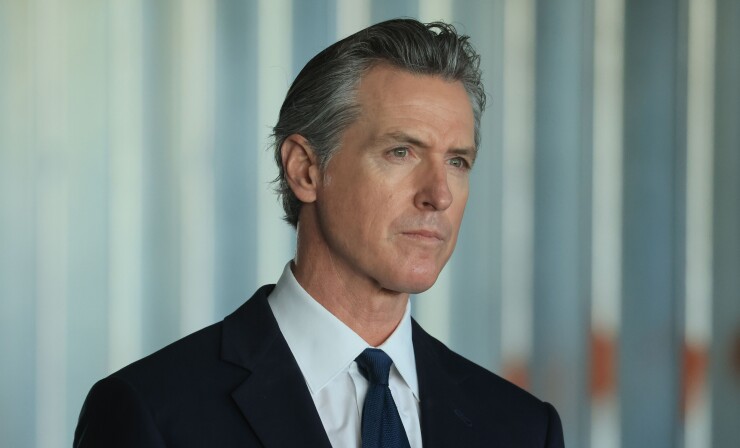As California grapples with tax revenue shortfalls that threaten his state policy ambitions, Gov. Gavin Newsom delivered an unusual State of the State speech that critics said barely touched on the state's challenges.
The
The speech came after the governor and the legislature's leaders, all Democrats,

The governor signed the primary legislative budget bill Wednesday following some last-minute changes, beating the Sunday signing deadline ahead of the July 1 start of the new fiscal year.
The State of the State has been historically delivered in the Assembly chamber in late January to outline a governor's policy agenda for the year to lawmakers.
Newsom hasn't been a stickler for that tradition. Last year he made a four-stop tour of the state. In 2021, amid COVID-19 restrictions against gatherings, he delivered the speech to an empty Dodgers Stadium.
The theme of this year's speech was largely a comparison between what the governor called the California Dream and defending it against Republican efforts nationwide to roll back tolerance, women's rights and LGBTQ+ rights while spreading gun violence and pollution.
The California dream and its values "and our way of life are the antidote to the poisonous populism of the right, and to the fear and anxiety that so many people are feeling today," Newsom said. Those values are under attack by "conservatives and delusional California bashers, because their success depends on our failure."
State Sen. Brian Dahle, R-Bieber, and Assembly Republican Leader James Gallagher, R-Yuba City, released a video
The state is "a hot mess under [Newsom's] failed leadership, and we know this because of the massive budget hole," Dahle said.
"This governor has been wholly uninterested in the results of all the money he has squandered, and has fixated on focusing on Texas and Florida," Dahle said.
The Republican added among a
Heading into the final stretch of his two terms, Newsom's popularity has declined to a 47% approval rate among registered voters in a
Newsom didn't announce any major new initiatives in his speech, but referenced the CARE Court System he
One reason the State of the State came late is that Newsom said he wanted to wait for results of the
The measure, which passed in a 50.2% to 49.8% vote, wasn't called until 15 days after the election by The Associated Press.
Newsom repeated his claim that no one has done more in recent history at the state level to reduce the number of people living on the streets, adding that his first State of the State speech after taking office in 2019 focused exclusively on reducing the problem.
According to his count, 9,300 encampments have been cleared and 15,300 units of housing have been built, providing shelter to more than 71,000 people. Funding from Proposition 1 will add another 11,000 new beds and housing units, he said.
"We're requiring counties and cities and the state to focus existing money on housing and treatment for the toughest cases," Newsom said.
Newsom said the state is approving its first-ever two-year balanced budget in what the governor called a disciplined approach that keeps the state on a strong fiscal footing.
The budget troubles of recent years are showing signs of eroding the state's bond ratings.
Moody's Ratings
S&P Ratings
The state's GOs were most
Lead manager JPMorgan was able in final pricing to cut spreads five to 10 basis points from retail sales, pricing to yield from 3.12% for 2025 maturities to 3.89% for 2053.
Moody's is still weighing whether any of the factors that led to the negative outlook have changed.
"I think that is a good question," said Matthew Butler, a Moody's vice president and senior analyst. "I think the gap the state is confronted with has arguably changed in magnitude as a result of the state's efforts to close it through spending reductions and reserves."
Moody's had noted previously the state's large reserves were a credit strength, Butler said, and using them in this situation is what they are for, but there is still a question regarding what the longer term outlook for the state will be as it comes out of the current situation. And more specifically, how will revenue perform over the next few years, he said.
"Is the state in a position to maintain a balanced budget while potentially replenishing its reserves going forward?" Butler asked. "That is a longer term question that could extend multiple years. That is the big picture situation for California."
In terms of some of the fixes the state employed to close the budget gap, like promising funding in future years to schools, which have raised questions because of similarities to questionable tactics deployed by the state post-2008 crash like issuing IOUs, Butler said the solutions California has employed are not surprising or that unusual given the situation.
"I would say that what we are seeing right now in terms of crafting a solution using a combination of spending reductions and the use of reserves is not unexpected," Butler said. "We would expect a similar reaction from most states."
In its May commentary, authored by Butler, Hetty Chang, an associate managing director, and Timothy Blake, a managing director, Moody's said: "While not expected, an economic downturn in the next year or two would materially compound the state's fiscal challenge."
Though Butler said the governor and lawmakers' efforts to not only close the deficit this year, but to contemplate budget solutions in a two-year time frame is considered prudent, the state is not out of the woods.
"Assuming the state takes action to close the deficits it currently projects beyond fiscal 2026, it would still operate with slim reserves, making it more vulnerable to a recession," Butler said. "Rebuilding reserves will necessitate annual operating surpluses, which may be dependent on revenue growth that outpaces the state's current projections."





